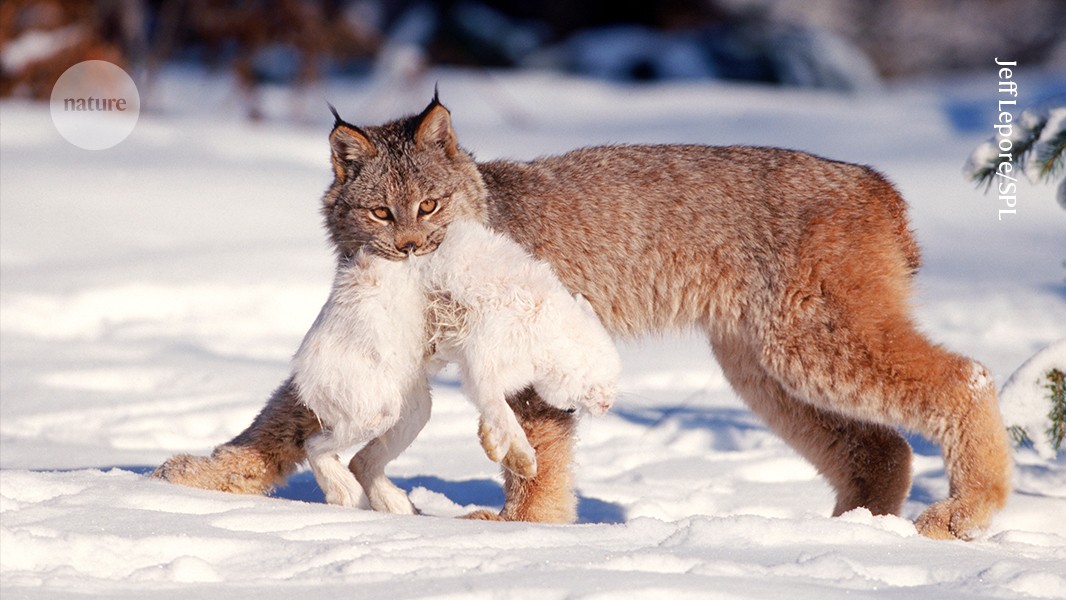GPS Tracking Reveals Lynx Population Dynamics Depend on Hare Movements Across Alaska
Conceitos Básicos
Long-range tracking of Canada lynx reveals that their dispersal, survival, and reproduction are closely tied to the movements of their primary prey, snowshoe hares, across large spatial scales.
Resumo
- Bibliographic Information: Arnold, D. A. et al. Proc. Natl Acad. Sci. USA 121, e2414052121 (2024).
- Research Objective: This study aimed to understand how the dynamics between Canada lynx and snowshoe hares, typically observed on smaller scales, play out across the expansive landscapes of Alaska.
- Methodology: Researchers fitted 143 Canada lynx with GPS collars to track their movements, survival rates, and reproductive success across Alaska. This data was then analyzed to understand how these factors correlated with the distribution and abundance of snowshoe hares.
- Key Findings: The study found a strong correlation between lynx movements and snowshoe hare populations. Lynx dispersal, survival, and reproduction were all significantly influenced by the availability and movement patterns of hares across the Alaskan landscape.
- Main Conclusions: These findings confirm that the predator-prey relationship between lynx and hares, often observed as cyclical population fluctuations, operates on a much larger spatial scale than previously documented. This highlights the importance of considering landscape-level dynamics in predator-prey relationships.
- Significance: This research significantly advances our understanding of predator-prey dynamics in large ecosystems. It demonstrates the crucial role of prey availability and movement in driving the spatial distribution, survival, and reproductive success of predators.
- Limitations and Future Research: While the study provides valuable insights, further research could investigate the influence of other factors, such as competing predator species or variations in habitat quality, on lynx-hare dynamics.
Personalizar Resumo
Reescrever com IA
Gerar Citações
Traduzir Texto Original
Para Outro Idioma
Gerar Mapa Mental
do conteúdo original
Visitar Fonte
www.nature.com
GPS tracking reveals how hares shape lynx populations
Estatísticas
143 Canada lynx were tracked in the study.
Citações
"Where snowshoe hares (Lepus americanus) roam, Canada lynx (Lynx canadensis) are expected to follow."
Principais Insights Extraídos De
by Abigail Klop... às www.nature.com 10-08-2024
https://www.nature.com/articles/d41586-024-03272-x
Perguntas Mais Profundas
How might climate change, particularly its impact on snowshoe hare habitat, affect the long-term dynamics of the lynx population?
Climate change has the potential to significantly disrupt the finely tuned predator-prey relationship between Canada lynx and snowshoe hares, with cascading effects on lynx populations. Here's how:
Habitat Alteration: Climate change can lead to shifts in plant communities, affecting the availability of the food resources snowshoe hares rely upon. A decrease in suitable hare habitat directly translates to lower hare densities, impacting the primary prey base for lynx.
Snow Cover Changes: Changes in snow accumulation and timing can impact both predator and prey. Reduced snowpack can make it harder for lynx, who rely on their large paws for navigating snow, to effectively hunt hares. Conversely, a mismatch in the timing of snowmelt and hare coat color change (from white to brown) could make hares more vulnerable to predation.
Range Shifts: As temperatures warm, both hares and lynx may experience shifts in their geographic ranges, potentially leading them to encounter new competitors, predators, or diseases. This can further complicate population dynamics.
These factors highlight the vulnerability of specialized predator-prey relationships like the lynx-hare system to climate change. Disruptions to this delicate balance can have long-term consequences for the persistence of both species.
Could factors other than hare availability, such as competition with other predators or disease prevalence, also play a significant role in lynx population dynamics?
While snowshoe hares are the cornerstone of the Canada lynx diet, it's crucial to recognize that other ecological factors can also influence lynx population dynamics:
Competition: Lynx share their habitat with other predators like coyotes, bobcats, and wolverines. Fluctuations in the populations of these competitors, perhaps driven by changes in their own prey availability, can indirectly impact lynx by increasing competition for resources.
Disease: Both lynx and hares are susceptible to various diseases and parasites. Outbreaks can cause significant mortality in either species, leading to population crashes that reverberate through the food web. For example, a decline in hare populations due to disease could lead to a subsequent decline in lynx.
Human Activities: Habitat loss and fragmentation due to human activities like logging and development can negatively impact both lynx and hare populations. Additionally, trapping and hunting pressure on lynx, even if regulated, can influence their numbers.
Understanding these multifaceted interactions is essential for effective conservation. Focusing solely on hare availability without considering the broader ecological context could lead to an incomplete understanding of lynx population dynamics.
If predator-prey relationships are inherently linked to landscape-level dynamics, how can conservation efforts be tailored to better protect both species within interconnected ecosystems?
Recognizing the interconnectedness of predator-prey relationships and landscape-level dynamics is crucial for effective conservation. Here are some approaches to consider:
Ecosystem-Based Management: Shifting from single-species management to an ecosystem-based approach that considers the needs of multiple species and their interactions is essential. This involves managing for healthy populations of both predator and prey species.
Habitat Connectivity: Protecting large, contiguous areas of habitat and creating corridors that allow for movement between fragmented landscapes is vital for both lynx and hares. This facilitates dispersal, gene flow, and access to resources, enhancing population resilience.
Climate Change Mitigation and Adaptation: Incorporating climate change projections into conservation planning is crucial. This includes identifying and protecting areas that are likely to remain suitable habitat in the future and implementing strategies to mitigate the impacts of climate change on both species.
Monitoring and Research: Continued monitoring of lynx and hare populations, as well as research into the factors influencing their dynamics, is essential for adaptive management. This allows for adjustments to conservation strategies as new information becomes available.
By adopting a holistic approach that considers the complex interplay of factors influencing predator-prey relationships within the context of a changing environment, conservation efforts can be more effective in safeguarding the long-term persistence of both Canada lynx and snowshoe hares.
0
